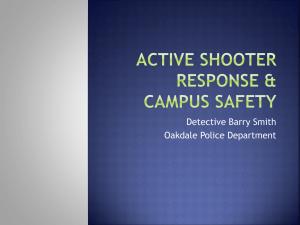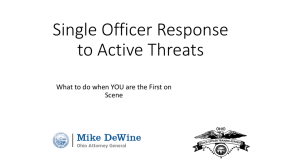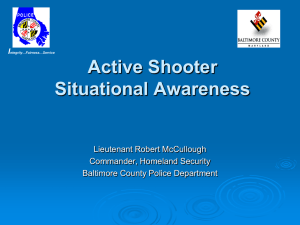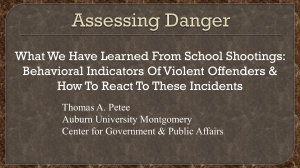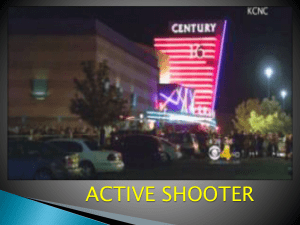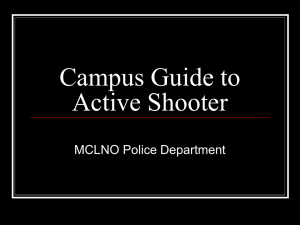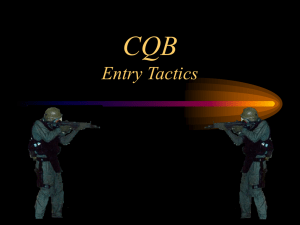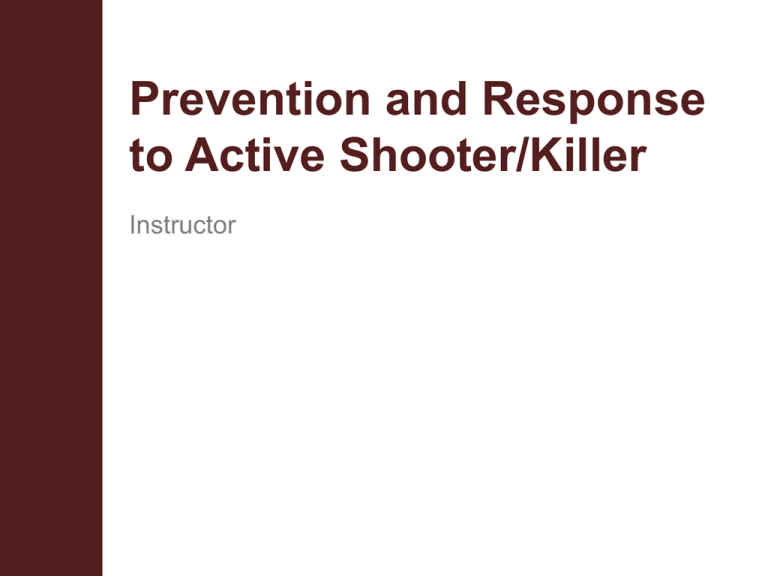
Prevention and Response
to Active Shooter/Killer
Instructor
“The first problem is not what we do when
the bad guys get into the classroom, but
rather how we keep them out in the first
place.”
“Once the bad guy gets into the classroom,
we are left with nothing but bad options.’
- Lt. Col. Dave Grossman
Terminal Objective
Part I
Upon completion of this module, the
participant will be able to identify the active
shooter/killer threat to schools including
the goals and tactics of the attackers. The
participant will also be able to describe the
emergency management model for
prevention and response to an active
shooter/killer.
Enabling Objectives
Identify the five components of the campus
community active shooter prevention and
response process
Identify the five components to the
emergency management cycle
Discuss the six components of campus
prevention/mitigation/and preparedness from
violent behavior
Describe the various types of active shooter
threat goals and tactics
What Must We Do?
Deter
Detect
Delay
Disengage*
Defeat
Lt. Col. Dave Grossman (2010)
* Steve Ramirez (2011)
Campus Community Preparation & Response to
Violent Threats
Emergency Management Model
Campus Community Preparation & Response to
Violent Threats
Emergency Management Model
Prevention
Mitigation
Preparedness
Response
Recovery
Mitigation/Preparedness
Threat Assessment
Physical Safety/Security
Cultural Safety/Security
Information/Intelligence
Communications
Emergency Management
Threat Assessment
Threat Assessment
Plan
Threat Assessment
Group
Counseling/Health
Services
Employee Assistance
Program
Code of
Conduct/Disciplinary
Referral
Community
Awareness/Reporting
Emergency
Notification
Joint Information
Center
Victim/Family
Assistance
Physical Safety/Security
General Safety/Security Environment
Fire/Emergency Medical
CCTV Surveillance/Alarms/Monitoring
Architecture/Landscaping
Access Control
Cultural Safety/Security
Situational Awareness
Active Empowerment
Effective Communications
Communications Philosophy
Ensure Effectiveness of:
Internal Communications
External Communications
Communications
Emergency Telecommunications
Public Information
Web-Site Development and Application
Social Media
Emergency Communications
Redundancy
Regular Testing
Automatic Enrollment
Staff Training
Timely
Target Specific
Secure
Redundancy
Phone Notification
Message Boards
Voice Notification
Computer Network Notification
Campus TV/Radio
Campus Newspapers/News Letters
Emergency Management
“All Hazards” or “Multi-Hazard” approach
Planning
Training
Exercising
Emergency Operations Center
Location Identified
Power and Utilities
Communication
Security
Emergency Management (NIMS/ICS)
Understanding the Threat
(Active Shooter/ Killer)
What is the “profile” of a school
shooter/killer?
One Size Does Not Fit All
Focus on Tactics… Not Who it Might Be
Limited Number of Tactics
Target Often Dictates Tactics
Understand the Goals of the Attack
-John Giduck (2010)
Understanding the Threat
(Active Shooter/ Killer)
Single Student Shooter
Low # Student Shooters
High #/Multiple Student Shooters
Young Adult Shooter
Adult Shooter
Terrorist Attack (Al-Qaeda)
Potential Attack Methods
Active Shooter/Decimation Assault
(Columbine/Virginia Tech) “Enthusiastic
Amateurs”
Mass Hostage Siege (Beslan)
Hybrid/Synergy (9-11)
Symphonic (Mumbai)
-John Giduck (2010)
Single Student Shooter
(Examples)
Teen Is Held in Deadly School Shootings; Slayings:
14-year-old boy used high-powered rifle to kill
teacher, two students, police say. The violence
leaves a tiny Washington community in shock.
(Moses Lake, 1996)
OMAHA, Neb. -- An angry online posting from the
17-year-old boy who opened fire at a Nebraska high
school, fatally wounding an assistant principal before
later killing himself, offers some clues about why the
son of a police detective turned violent a couple of
months after transferring there. ( 1/05/2011)
Single Student Shooter
(Tactics)
Specific Target(s)
May be preceded by a catalytic event such
as expulsion/suspension/bullying
Not Planning to Fight Police (Suicide)
Low# Student Shooters
(Example)
High #/Multiple Student Shooters
(Examples)
Alaskan boys 'planned school massacre' Six
13-year-olds arrested in Santa Claus town
Pupils allegedly plotted to cut power and
phone lines.
RIVERTON, Kan. — Five teenagers
suspected of plotting a shooting rampage at
their high school will stay in custody through
the weekend while prosecutors decide
whether to file charges, a judge ruled
Saturday.
Multiple Student Shooters
Use Military Attack Plans
Ambush
“Hammer and Anvil” Attacks
IEDs
Use of Rear Guards
Predatory Response
Young Adult Shooter
(Example)
Young Adult Shooter
(Tactics)
Hostages Unlikely
Not Planning to Fight Police (Suicide)
Trained on Video Games, Paintball, Range
Looking for a Higher Body Count (killing is
easier with age)
-John Giduck (2010)
Adult Shooter
(Example)
Adult Shooter
(Tactics)
Uses Tactical Barriers
Hostages
Has Primary and Secondary Attack Goals
Sexual Assault is Often a Secondary Goal
-John Giduck (2010)
Terrorist Attack (Al-Qaeda)
Beslan
Terrorist Attack (Al-Qaeda)
Beslan
Al-Qaeda Proving Ground for U. S. Attacks
49 Al-Qaeda/Chechen Terrorists
3 Days in Duration
Over 1200 Hostages including 777
Children
334 Civilians Killed including 186 Children
21 Rescuers Killed
Terrorist Attack (Al-Qaeda)
Attack Phase
Submission & Control Phase
Stabilization Phase
Fortification Phase
“Negotiation” Phase
“Rescue” Phase
“Every hostage is a short term prisoner
on their way to execution.”
- John Giduck (2010)
“Sheep have two speeds, graze and
stampede.”
- Lt. Col. Dave Grossman
What Do We Do
Deter
Detect
Delay
Disengage
Defeat
Deter
Physical Safety/Security
Detect
Behavioral Assessment, Threat Assessment,
Cultural Safety/ Security,
Information/Intelligence
Delay
Lock Doors, Secure Area, Single Point of
Entry
Disengage
Evacuation or Escape by any means
Defeat
Police Response or Targets Fighting Back
(Capable Guardians)
“Denial has no survival value; it kills
twice: physically and psychologically.”
-Lt. Col Dave Grossman
The Police Response
Part II
(Defeat the Threat)
This Section of SBLE I Training is based
upon on the curriculum of the Advance Law
Enforcement Rapid Response Training
Center, http://alerrt.org/
and is presented in
partnership with ALERRT.
Terminal Objective
Part II
Upon completion of this module, the participant
will be able to demonstrate knowledge of:
Basic firearms safety, proper grip and stance,
and moving and shooting principals
Threshold evaluation/slicing the pie technique
Team movement techniques from solo officer
entry to five officer teams.
Setting up and conducting a room entry as a
solo responder and in a team of up to five
responders.
Hostage Barricade vs. Active
Shooter
Hostage Barricade
The 5 Cs are:
Contain
Control
Communicate
Call SWAT
Create a Plan
Active Shooter/Killer
Unlike the hostage barricade, the active
shooter is normally a planned event with the
goal of killing as many innocent people as
possible
If the hostage taker starts killing innocent
hostages, responders should have a plan to
enter, close distance, and neutralize the
threat.
Enabling Objectives
Part II-A
Identify and demonstrate the four universal firearms
safety rules
Demonstrate the high friction grip on a handgun
Demonstrate the modified low ready/combat ready
position
Demonstrate the “sul”/“safety circle” position
Demonstrate proper body positioning when moving
and shooting
Demonstrate and discuss the contact/cover principal
Demonstrate and discuss priority of fire concept
Discuss the importance of follow through, scanning,
and breathing during lethal force encounters
Weapons Manipulation
Universal Firearms Safety Rules
Two-handed “High Friction” Grip
Modified Low Ready/Combat Ready Position (traveling
position)
Position Sul or Safety Circle (used with Known
Friendlies in down range)
Universal Fighting Stance
Proper Body Position
Movement
First Responder Issues
6’ Reactionary Gap
Lower Weapon to Open Visual Field
Priority of Fire
Contact Cover Principle
Follow Through, Scan, and Breathe
Follow Through
Scan
Breathe
Enabling Objectives
Part II-B
Demonstrate safe weapons handling skills
Identify the purpose of conducting the threshold
evaluation/slicing the pie technique
Demonstrate the threshold evaluation/slicing the
pie technique moving at a slow, deliberate speed
Discuss and demonstrate the three methods of
communication with their partner while conducting
the threshold evaluation/slicing the pie technique
Demonstrate the threshold evaluation/slicing the
pie technique moving in a direct to threat speed
Threshold Evaluation
Deliberate Speed
Search Pattern
Body Position
Visual Searching Pattern
Reflective Surfaces
Methods of Communication
Three methods of communication between
first responders conducting a threshold
evaluation:
Nothing Found
Hand and Arm Signals
Gunfire
Enabling Objectives
Part II-C
Demonstrate safe weapons handling skills
Identify, discuss, and demonstrate the six concepts
and principles of team movement
Demonstrate team movement techniques from solo
officer entry to five officer teams
Recognize the appropriate speed of movement based
on the “actionable intelligence” provided to the first
responder
Demonstrate and explain how to utilize different team
movement techniques based on the crisis environment
Demonstrate and explain the proper technique to
bypass rooms that have not been cleared when
moving to a known threat location
Concepts and Principles of Team
Movement
Stay Together as Much as Possible
540° of Cover Around the Team
Communication
Cover the Angles
Threshold Evaluation
Speed of Movement
Two Man Movement
Tethered Movement
(Two-Man)
Strengths:
Easy to cover all angles, especially when stationary
Small target signature
Can move quickly using touch indexing to determine
speed
Weaknesses:
Weapon deployed using one hand
Responders in direct line with each other from front or
rear hostile fire
Gap in coverage to sides
Side By Side Movement
(Two-Man)
Strengths:
Both hands on weapon system
Responders not directly in line from back or front
Limited to no gap in coverage to the sides
Weaknesses:
Difficult to cover angles when stationary in a linear
danger area (such as a hallway)
Larger target signature
Difficulty in moving quickly
Three Man Movements
Tethered Movement
(Three-Man)
Strengths:
Easy to cover all angles, especially when
stationary
Smaller target signature
Can move quickly using touch indexing to
determine speed
Ballistic protection to rear guard from the front
Weaknesses:
Weapon deployed using one hand (rear guard)
Side By Side Movement
(Three-Man)
Strengths:
Both hands on the weapon system (all positions)
Responders not directly in line from back or front
Limited to no gap in coverage to the sides
Weaknesses:
Difficult to cover angles when stationary in a linear
danger area (such as a hallway)
Larger target signature
Difficulty moving quickly
Four Man Movement Techniques
Four Man Movement Techniques
Point Position
Left Cover Position
Right Cover Position
Rear Guard Position
Team Leader/Long Gun
Alternate Four Man Movement
Techniques
Diamond Movement
Strengths:
Easy to cover all angles, especially when stationary
Can flex into limited space environments
Can move quickly using touch indexing to determine speed
Ballistic protection to rear guard from the front
Weaknesses:
Weapon deployed using one hand (rear guard)
The point position is exposed if left or right cover fails to move
up and cover from the side a during deliberate speed entry
If not disciplined, priority of fire issues can arise
“T” Movement
Strengths:
Reduces priority of fire issues to the front—all
responders are in line
Left and right cover can cross cover angles to the front
Limited to no gap in coverage to the sides
Weaknesses:
Larger target signature
More difficult to move rapidly and maintain integrity of
the “T”
Requires more complex communication (cross
cover/switch)
“Y” Movement
Strengths:
Excellent movement technique when clearing intersecting
hallways
Left and right cover can maximize cross cover angles to the
front
Weaknesses:
Priority of fire issues if the point does not move up online with
left and right cover
More difficult to move rapidly and maintain integrity of the “Y”
Requires more complex communication (cross cover/switch)
Five Man Movement Techniques
Double Rear Guard Movement
Strengths:
Overlapping fields of fire around the team
Cross cover to the rear if the team becomes stationary
Can move quickly using touch indexing to determine speed
Increased ballistic protection around the team
Weaknesses:
Weapon deployed using one hand (rear guards)
The point position is exposed if left or right cover fails to move
up and cover from the side during deliberate speed entry
If not disciplined, priority of fire issues can arise
Special Skill/Knowledge Movement
Strengths:
One person controls the team using overall situational
awareness
Frees up a responder to use a radio to stay in communication
with other responders operating in the same environment
The responder with special skill/knowledge can direct the
team as it moves to close distance with the suspects
Increased ballistic protection around the team
Weaknesses:
Weapon deployed using one hand (rear guard)
Special skill/knowledge position must maintain discipline to
limit priority of fire issues
Enabling Objectives
Part II-D
Demonstrate safe weapons handling skills
Demonstrate methods for setting up for a room entry as a solo responder
and in a team of up to five responders
Demonstrate non verbal communication skills prior to room entry
Demonstrate room entry techniques as a solo responder and in a team of
up to five responders
Discuss and demonstrate team maintenance and the planning process prior
to leaving a secure room
Discuss and demonstrate the need for additional responders (support)
within a room
Discuss the room entry principles of speed, surprise, and violence of action
Discuss and demonstrate points of domination and fields of fire within a
room
Discuss and demonstrate the importance of communication within a room
Identify, discuss, and demonstrate the tactical room entry philosophy of
going to the “known” first
Identify, discuss, and demonstrate the tactical room entry philosophy of
going to the “unknown” first
Setting Up for Room Entry
Communication
Positioning
Principles of Room Entry
The Element of Surprise
Speed
Violence of Action
Final Words
This is only an introduction to the topic of
prevention and response to school based
active shooter/killer incidents.
Reality based training and exercises should
be an ongoing part of police training.
References/Resources
Lt. Col. Dave Grossman http://www.warriorsciencegroup.com/
John Giduck, Archangel Group Ltd.
http://archangelgroup.org/content_main/index.php
Advance Law Enforcement Rapid Response Training,
http://alerrt.org/
Kenneth R. Murray, “Training at the Speed of Life”
http://www.armiger.net/
Tony Blauer, http://www.tonyblauer.com/
http://www.denvergov.org/HomePage/CERT/tabid/426128/Def
ault.aspx
http://www.crisisconsultantgroup.com/wpcontent/uploads/2010/09/Active-Shooter-Response-TrainingBanner.jpg
http://www1.ben.edu/resources/publicsafety/Police_Training.a
sp


